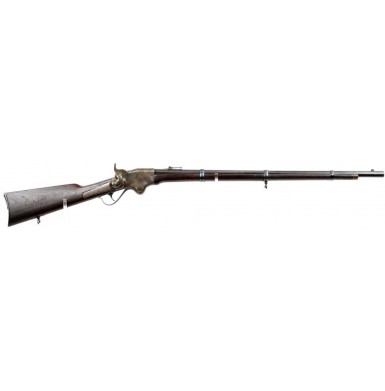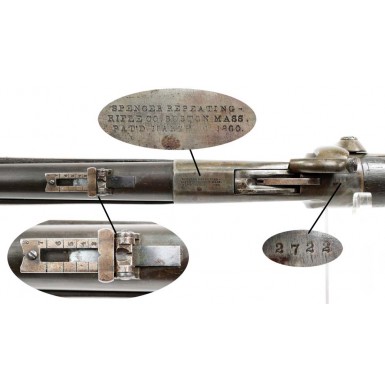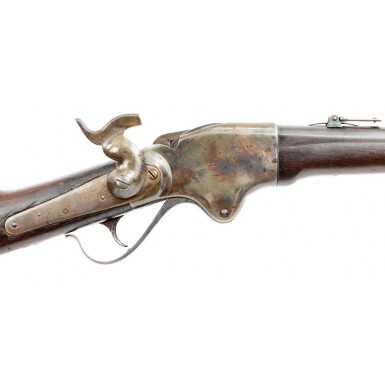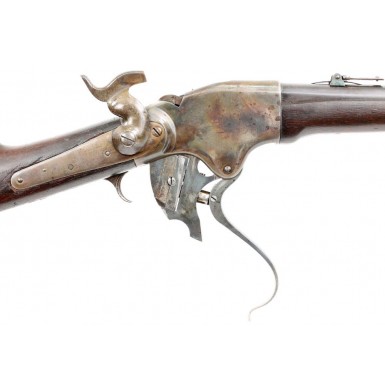There is probably no one weapon of the American Civil War is more representative of the overwhelming force of industry and technology brought to bear by the North against the South than the US M-1860 series of repeating rifles and carbines that are more commonly known simply by the last name of their inventor: Christopher Spencer. Even though the standard cavalry long arm technology of the pre-Civil War era US military, the single-shot breech-loading percussion carbine, was still in heavy use through the closing days of the war, the era of the repeating metallic cartridge used in rifles and carbines was firmly established by the end of 1863. The “Horizontal Shot Tower”, as some affectionately referred to the Spencer Rifle (and carbine), was in essence the original assault rifle. Although the Henry Rifle offered more cartridges in the magazine, the .44RF Henry round was essentially the ballistic equal to a pistol cartridge. The .52 caliber 56-56 Rim Fire Spencer cartridge was much more comparable to a real service rifle load, and delivered far greater downrange stopping power. The Spencer was also very fast to reload, with a 7-round tubular magazine that fed through the buttstock; soldiers could carry pre-loaded tubes and reload the magazine in just a few seconds. While the Spencer shooter did have to manually cock the hammer for each shot (the Henry had a speed advantage here, since the toggle action that operated the bolt to eject the old cartridge and load a new one also cocked the hammer), the robust design and relatively powerful cartridge combined to make it the most prized and most feared long arm of the American Civil War. 11,470 Spencer military rifles were delivered to the US military between 1863 and 1865, and nearly five times that many carbines saw service as well. The rifles were produced in two fairly specific serial number ranges, with the early order being found in the 700 to 11,000 range and a later order found mostly in the 22,000 to 24,000 range. A handful of rifles were intermixed in the serial number ranges of the carbines, but the large majority of rifles extant exist in these two specific serial number production ranges. The 30” barreled, “3 band” rifle was designed to take a US angular socket bayonet that was almost identical to the standard US M-1855 socket bayonet, although it has a slightly larger socket diameter, taller bridge to accommodate the front sight, and was unmarked with the exception of a small inspector’s mark forward of the mortise cut. The rifles were the first of the Spencer repeaters ordered by the Ordnance Department and were the first Spencers to see service in the field. While no Spencer carbines were in the field at the time of the battle of Gettysburg (July 1-3, 1863), the 5th Michigan cavalry (part of Custer’s brigade) was armed with the Spencer “Army” rifle and used them very effectively on July 3 against General J.E.B. Stuart’s cavalry. Spencer rifles with serial numbers below approximately 1550 have the potential of being among the guns issued to the 5th Michigan Cavalry in time for use at that battle. Spencer rifles also saw significant service in the Western Theater, most notably by Colonel Wilder’s Lighting Brigade of mounted infantry. Wilder initially tried to obtain Henry rifles for his mounted infantrymen, but found that an order for 900 was more than could be manufactured by the fledgling New Haven Arms Company. At about this time, Christopher Spencer himself had undertaken the roll of company spokesperson and travelling salesman, and was visiting the camps and commanders of the Union Army in the Western Theater. Spencer greatly impressed Union General William Rosecrans, who immediately requisitioned some 2,000 of the rifles from Chief of Ordnance James Ripley. Another commander who was impressed by Spencer and his rifle was Colonel John T. Wilder. In fact, Wilder was so impressed with Spencer and his rifle design that the colonel personally arranged financing to purchase enough Spencers rifles to outfit his entire brigade, and allowed the men to purchase their own rifles on credit, with the cost of the guns deducted from their pay over time. The initial order was for some 1,400 rifles, at a per unit price of $35 each. Wilder’s confidence in the weapon was well founded, but his willingness to risk financial ruin by personally guaranteeing the loan of nearly $50,000 to purchase the weapons (roughly one million dollars today just in terms of inflation) truly underlines how confident he was in their success. Wilder’s men first put their new repeating rifles to good use at the Battle of Hoover’s Gap in during the Tullahoma Campaign in early summer of 1863, and provided massive supporting fire during the Battle of Chickamauga that helped to save the Union Army from potential destruction during heavy fighting on the first day. As many of the early Spencer Rifle purchases were made by states, or private individuals like Wilder, and as such, these arms did not have government sub-inspection and inspection marks or cartouches, as those arms that were directly contracted for by the US Ordnance Department did.
This is a VERY FINE+ condition example of an early production, privately purchased M-1860 Spencer Army Rifle. The gun is in complete and 100% original condition. The gun is in its original Civil War configuration and has none of the post war modifications or alteration that were made to some of the Spencer rifles in the latter part of the 1860s. The action works perfectly, with the lever cycling the action smoothly and the extractor working exactly as it should. The hammer cocks as it should and responds to the trigger crisply. The original magazine tube is present and in very good, functional condition. It is the correct Civil War era style with a smooth base plate, not the Indian War era grooved base plate version that is more common and often found as a replacement in Civil War era guns. The magazine tube in in very fine condition, both physically and mechanically. The gun retains both of its original sling swivels, both the one in the lower buttstock and the one on the middle barrel band. The original rear sight is in place, is complete and is fully functional. The original front sight, complete with the brass blade insert, is present at the end of the 30” barrel. The gun retains crisp, legible markings on the receiver, the top of which is marked in three lines:
SPENCER REPEATING -
RIFLE CO BOSTON MASS,
PAT’d MARCH 6, 1860
The serial number 2722 is stamped into the rear of the upper receiver, in front of the buttstock joint, and the matching number is present under the barrel, forward of the receiver, hidden by the forend. The bottom of the barrel is additionally marked with the file slash assembly mark | \/ / / which is also found inside the walnut forend. The bottom of the barrel is also marked 52, indicating the bore diameter of the rifle. This low serial number places the rifle in the first part of the first group of serial numbers that Spencer rifles are found in, and indicates that the rifle was almost certainly manufactured and shipped by mid-1863. Recorded serial numbers with issue dates show that Spencer Rifles #2703, 2707, 2710 & 2711 were all in the field as of February 25, 1863, in the hands of the 7th Independent Company of Ohio Sharpshooters, who would eventually be known as “Sherman’s Bodyguards”, because of their assignment to protect that Union general. The 7th was placed in a battalion with the 5th and 6th Independent Companies of Ohio Sharpshooters, and all three companies were armed with Spencer rifles. After consulting the four-volume set of Springfield Research Service serial number books, the closest serial numbers to this rifle (#2722) that are recorded are #2717, #2718, #2731 and #2734. The closest number on that list to this rifle is #2718, which is only four numbers away. #2718 was issued to the 5th Independent Company of Ohio Sharpshooters, #2717 was issued to the 6th Independent Company of Ohio Sharpshooters, #2731 was issued Company H of the 28th Kentucky Volunteer Infantry, and #2734 was issued to Company E of the 72nd Indiana Volunteer Infantry, which joined Wilder’s Brigade in October of 1863. While it is impossible to pin down exactly which unit may have used this Spencer rifle, based upon the distribution of rifles in the surrounding serial number range, it seems quite likely that this rifle served with a Western Theater unit from about the spring of 1863 through the Atlanta Campaign, and then either made the “March to the Sea” with one of the Ohio Sharpshooter companies, or made the trek north to Middle Tennessee for the battles of Franklin and Nashville. Either way, it certainly appears to be a Western Theater rifle.
As noted the rifle is in about VERY FINE+ overall condition. The gun retains most of its original finish on the metal, with some additional patches of darker brown surface oxidation and age discoloration scattered here and there. The barrel retains roughly 80% original blue, which has faded and dulled somewhat, and shows some thinning. The balance of the barrel has developed a smooth plum brown patina that has blended seamlessly with the original blue. The barrel shows some scattered areas of minor surface oxidation and a few small spots of minor corrosion and surface roughness, mostly near the muzzle. The case-hardened receiver retains about 80%+ of its original mottled colors, which is mostly vivid, but is starting to fade around the edges and shows some loss along the edges and points of contact. Like the barrel, the receiver shows a few flecks of minor oxidation and discoloration, along with a few small areas of minor surface roughness and corrosion, the most prominent being a thumb sized area of surface roughness at the rear part of the receiver on the reverse. Most of the places where the finish on the receiver as faded or worn show the usual “silvered out” appearance of faded case coloring. The hammer retains a similar amount of case hardened colors, matching the receiver well. The buttplate retains about 50% faded case coloring, and has a more muted appearance. The barrel bands retains much of their bright, fire blued finish but are starting to fade and dull with age. The metal of the rifle is mostly smooth throughout, but does show some lightly scattered surface oxidation and small patches of corrosion, as mentioned. The bore retains crisp 6-groove rifling, remains quite bright and rates about FINE overall. The bore shows some very lightly scattered pitting along its length, but nothing major, with most of the minor erosion in the last few inches nearest the muzzle. The overall bore condition matches the outside of the gun very closely. The stock and forend are in about FINE condition as well. Both retain a nice, open grained appearance with some “feathers’ to the wood. Both the buttstock and forend are in solid condition, and are free of any breaks or repairs. Even the usually encountered crack in the butt, along the channel of the magazine tube, is missing. This area is notoriously weak as the wood of the butt is so thin where the channel of the magazine was hollowed out. The butt and forend do show the expected bumps, dings and mars from handling and use in the field. The butt shows a couple of slightly deeper mars and scrapes on the left side, and there is a larger ding on the reverse of the forend, just forward of the middle barrel band. The forend also shows a minor sliver missing where it meets the receiver on the obverse, a place where both Spencer and Sharps forends are notoriously weak and often show damage, even on nearly pristine examples. Both pieces of wood remain extremely crisp and show no signs of having been sanded or refinished, and are really in fine condition for a Spencer rifle, as the both pieces of wood have areas that are notoriously thin and prone to damage.
The overall condition of this Spencer rifle is really very fine, especially for a gun that was produced so early and likely saw significant field service during the last half of the Civil War. The gun is complete, and all original and is a very reasonably priced for such an attractive example of a very important, martially marked Civil War weapon. Significantly fewer Spencer rifles were produced than the carbines, and their association with Custer’s cavalry and Wilder’s famous Lightning Brigade make them extremely desirable collector’s items. The only real detraction is the small sliver missing from the forend, a minor issue that could be resolved by a talented wood restorer, if so desired. If you have always wanted a really fine Spencer rifle for your collection with lots of finish this would be a great example to acquire, at a reasonable price without breaking the bank.
SOLD






